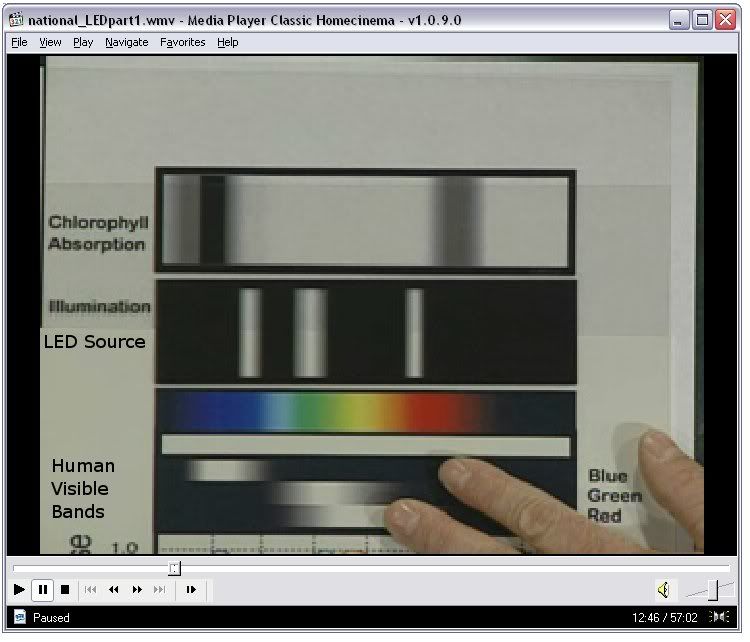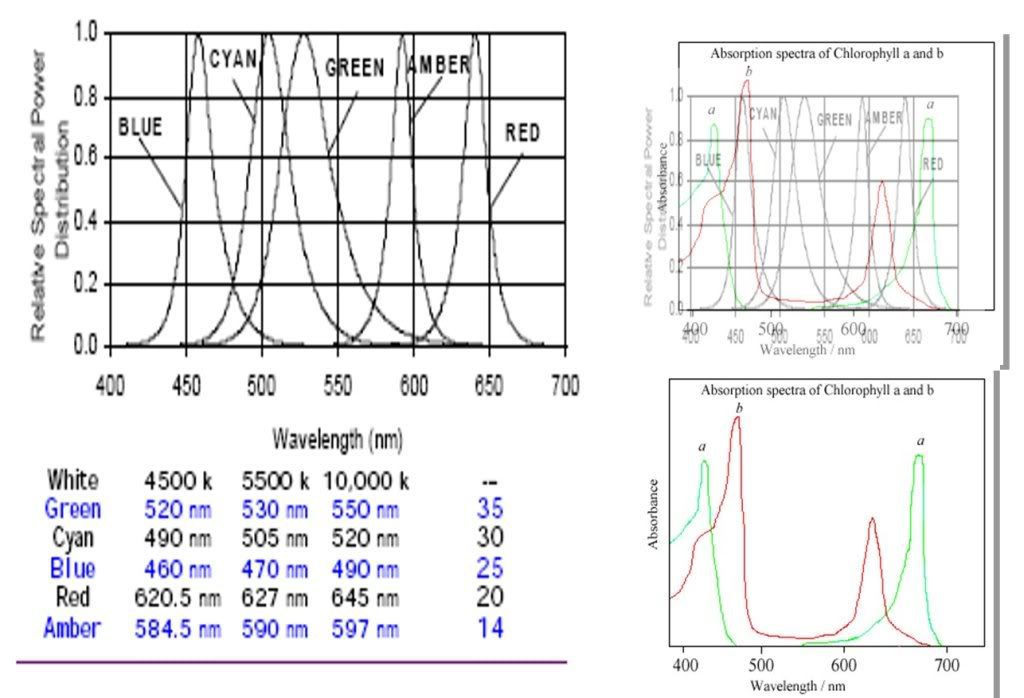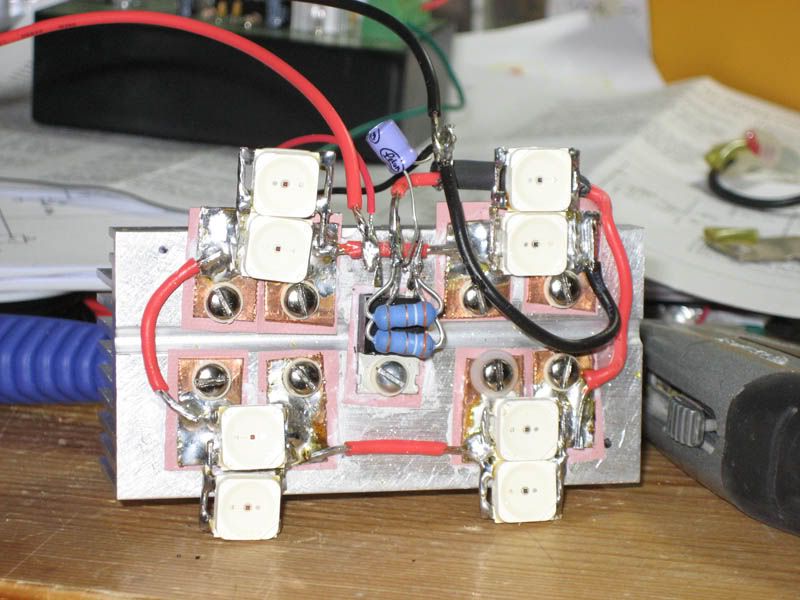


Donate Now
and become
Forum Supporter.

Many perks!
<...more...>


|

01-17-2008, 05:02 PM
|
|
Senior Member
|
|
Join Date: Sep 2007
Posts: 286
|
|
 Why LEDs make bad plant lights (facts + pics!)
Why LEDs make bad plant lights (facts + pics!)
LEDs are not good for growing plants. Here's why:
1) They are NOT efficient, they only manage 40-50 lumens per watt. fluorescents and HIDS are in the 80-120 range.
2) LEDs do not put out light in the chlorophyll absorption bands... i.e. the light LEDs put out are very narrow banded and useless to plants. White LEDs are also fairly useless because the blue is too high in the spectrum, and they fade out before reaching the red spectrum chlorophyll requires.
Here we see a graph produced by National Semiconductor guest speaker from Future LEDs, with Philips Lumileds representative, and a nat semi engineer all in concurrence. It's a movie, I had to take a screen shot, the Future LEDs rep actually said "If you tried to grow a plant with this kind of light, it wouldn't grow very well."
The top part is the absorption bands of chlorophyll, black is where the light NEEDs to be to be useful to plants. You can correlate that to the color chart below.
The second section is the emission spectrum of Blue 470nm, green 525nm, and red 630nm LEDs... You can see clearly that all of the light output of LEDs falls TOTALLY outside the range of chlorophyll absorption.
Next section is the color chart, fairly self explanatory.
The bottom section is our color receptors each respectively, Blue, Green, and Red which over lap... LEDs are useful for human vision, but their narrow peaks make them useless for the purpose of growing plants.
It's a common misconception that LEDs are "cool" they actually are less efficient, but all of the heat goes out through the back through the metal substrate, where as normal light bulbs put heat out where the light goes!
If you want to see the entire presentation, please go here (you must register, but don't worry they're good about not giving out addresses):
Analog By Design Show 6

LEDs are wonderful for lots of things... Plants are not one of them.
Last edited by Ocelaris; 01-17-2008 at 05:05 PM..
|
|
Post Thanks / Like - 2 Likes
|
|
|
|
|

01-17-2008, 05:17 PM
|
|
Senior Member
|
|
Join Date: Sep 2006
Zone: 5a
Posts: 9,277
|
|
Great post Ocelaris. I just wish this LED thing would go away! There isn't a magic elixir, sorry.
|

01-17-2008, 08:45 PM
|
|
Senior Member
|
|
Join Date: Sep 2007
Posts: 286
|
|
Thanks, If LED makers COULD improve their efficiency and get the correct combination of semiconductors to produce light in the correct wavelengths, then we'd have a super powerful product. We could in the future, but not yet.
They do have some experimental white LEDs which produce up to 100 lumens per watt, but their spectrum is based on a blue LED with phosphors, so it's fine for general purpose lighting, but wavelengths are not there for plants.
Unless they discover some magic combinations of semiconductors with spectral patterns in the right regions, I see flourescents really winning this battle.
|

01-20-2008, 08:00 AM
|
|
Jr. Member
|
|
Join Date: Jan 2008
Posts: 3
|
|
 Successful growing
Successful growing
I'm going to have to disagree here. I have grown tomatoes to flower and produced tomatoes. grown lavender and other plants using 1w lumileds.
Yes they are not fantastic for doing this but there is a lot of potential. I have however noticed that the leaves do burn when the get too close to the LED. this is a misconception that they don't get hot and so can be put right up against the plant. cost is the current killer. lumens per dollar to setup a LED grow is much higher than any other type of light.
|

01-25-2008, 04:54 PM
|
|
Senior Member
|
|
Join Date: Sep 2007
Posts: 286
|
|
here's a new graphic I made, basically 470nm blue LEDs seem to be useful for chlorophyll B, but they don't have RED LEds in the right area... You can grow plants with LEDs, but you can also grow plants with incandescents. They just need to "shift" the color of the LEDs to more closely resemble the chlorophyll spectrum and we'll be in heaven.
 |

01-25-2008, 08:32 PM
|
|
Jr. Member
|
|
Join Date: Jan 2008
Posts: 3
|
|
 exactly
exactly
Quote:
Originally Posted by Ocelaris

here's a new graphic I made, basically 470nm blue LEDs seem to be useful for chlorophyll B, but they don't have RED LEds in the right area... You can grow plants with LEDs, but you can also grow plants with incandescents. They just need to "shift" the color of the LEDs to more closely resemble the chlorophyll spectrum and we'll be in heaven.
|
I have several of these graphs. If you look at the LUMILED datasheets you can get binned product with higher wavelenghts that get you closer to the ideal wavelegth. if you overlay this LUMILED spectrum over the Chlorophyll spectrum. then you find that LUMILEDS are about 60% efficient at producing light for photosynthesis. Which I might add is a hell of a lot better then every other light source. Its not perfect but it does work. The problem with LED's is that you actually need to add heat during the cooler times of the year. whereas lamps like HPS require much ventilation to make sure the heat does not build up. but the temperature stays quite constant. I tried growing tomatoes during winter with LED's and the room was just too cold for them.
 Phil

|

01-27-2008, 07:31 AM
|
|
Member
|
|
Join Date: Sep 2007
Posts: 61
|
|

I would also have to disagree..
First of all the comparison of lumens/Watt between white LEDs and HID lamps is not relevant since you would never use white LEDs as plant lights.. Why waste energy producing light in wavelengths not needed??
There are many LEDs out there in wavelengths of 400-420nm, 460nm, 640nm and 660nm which are perfect in terms of color, but they are not 1W high power LEDs, they are 5mm, and they are not very bright. However, they are able to produce the exact wavelengths need by chlorophyll a and b, which might make up for their lack of lumens/Watt. We'd have to experiment a bit here since I don't think we're able to make valid comparisons with HID through PAR - real life growing areas with identical setups in terms of Watts would be needed..
It's true that Phillips and their colored Luxeons are not close to the right wavelengths, but there are MANY MANY other producers of LEDs out there. I've actually found one place selling 1W High Power LEDs in the above mentioned wavelengths, but they were designed specifically for medical use and hence they are waaaay to expensive..
What I'm getting at is that I don't think LEDs will make bad plant lights at all - the luxeons will - but not LEDs in general.
Christian

|

01-27-2008, 10:50 AM
|
|
Jr. Member
|
|
Join Date: Jan 2008
Posts: 3
|
|

Quote:
Originally Posted by korxi

I would also have to disagree..
First of all the comparison of lumens/Watt between white LEDs and HID lamps is not relevant since you would never use white LEDs as plant lights.. Why waste energy producing light in wavelengths not needed??
There are many LEDs out there in wavelengths of 400-420nm, 460nm, 640nm and 660nm which are perfect in terms of color, but they are not 1W high power LEDs, they are 5mm, and they are not very bright. However, they are able to produce the exact wavelengths need by chlorophyll a and b, which might make up for their lack of lumens/Watt. We'd have to experiment a bit here since I don't think we're able to make valid comparisons with HID through PAR - real life growing areas with identical setups in terms of Watts would be needed..
It's true that Phillips and their colored Luxeons are not close to the right wavelengths, but there are MANY MANY other producers of LEDs out there. I've actually found one place selling 1W High Power LEDs in the above mentioned wavelengths, but they were designed specifically for medical use and hence they are waaaay to expensive..
What I'm getting at is that I don't think LEDs will make bad plant lights at all - the luxeons will - but not LEDs in general.
Christian
|
Yeah well said. however luxeons do work, just are not 100% efficient like the 5mm ones. more like 40-60%. HPS is like 10% efficient. If we could get the cost down, LED should prove to be really good lighting sources for growing. Unfortunately its not just the cost of the LED's that need to come down. its the constant current driving, and power supply hardware that also is not cheap right now. Building large arrays of 5mm LED's is also not a cheap operation. the cost effectiveness of LED setups are still in the infant stages. Commercial LED displays for lighting are making way for cheaper availability of this sort of stuff. but is still damn expensive.

|

01-27-2008, 05:30 PM
|
|
Senior Member
|
|
Join Date: Sep 2007
Posts: 286
|
|

These are all good points, I'm naturally very skeptical about how these would be implemented, and total cost and ease of use to the end user.
I think we all agree we are closer to a more perfect lighting source, but still some distance to go.
One thing I wonder, can they NOT make a florescent tube, with various phosphors that almost totally mimics the chlorophyll absorption spectrum? i.e. is it physically possible with the current technology to do what we imagine possible with LEDs? If so, it's discouraging to me, because it seems that LEDs aren't necessarily bringing anything new to the table if we've already been able to, but it has been economically not feasible. i.e. limited market and such no lights of that "perfect" nature were grown.
I'm just wondering if we're on the cusp of being able to tailor photosynthetic lighting efficiency to near perfection, or has it been already possible with phosphor/halide salt combinations and not economically rational.
We are more or less dependent on the commercial technology trickling down, and certainly sunlight trumps any artificial light just because it is free. I'm just trying to figure out how reasonable it would be to expect for this technology to evolve to fit our needs.
As for the end user ease of use factor, I'm concerned again about distance from the plants to the lighting source, in LEDs, you have such a relatively weak output, they would need to be very close to the plant, making it awkward... fluorescent tubes somewhat suffer from this, because they are a diffuse source of light, but we still see them as being quite popular. I think once LEDs become cheap enough to make large "banks" like fluorescent tubes, making narrow optics on the LEDs will give them a leg up on fluorescents.
Exciting times we're facing! I just hope everything pans out how we hope. I think people underestimate my love for LEDs, I am a big promoter of them, but understandably I am also cautious that anticipation does not overpower reality.
Here's a shot of the motorcycle brake light I made from 8x1w red LEDs, fairly ugly, but it got the job done... it gave me a lot of insight into the challenges and future of LEDs, power supplies etc...


|

01-28-2008, 06:18 AM
|
|
Member
|
|
Join Date: Sep 2007
Posts: 61
|
|
Regarding flourescents:
sera GmbH: sera plant color I've heard this should be the closest you get, but still alot of green and yellow light... 
The tail light looks nice :P I hope you've got something in front 
Christian |
|
Currently Active Users Viewing This Thread: 1 (0 members and 1 guests)
|
|
|
 Posting Rules
Posting Rules
|
You may not post new threads
You may not post replies
You may not post attachments
You may not edit your posts
HTML code is Off
|
|
|
 Similar Threads
Similar Threads
|
| Thread |
Thread Starter |
Forum |
Replies |
Last Post |
|
Dendrobium aggreatum majus
|
TOMD |
Dendrobium Alliance |
6 |
05-28-2007 02:31 PM |
All times are GMT -4. The time now is 11:11 PM.
|



































 Linear Mode
Linear Mode


